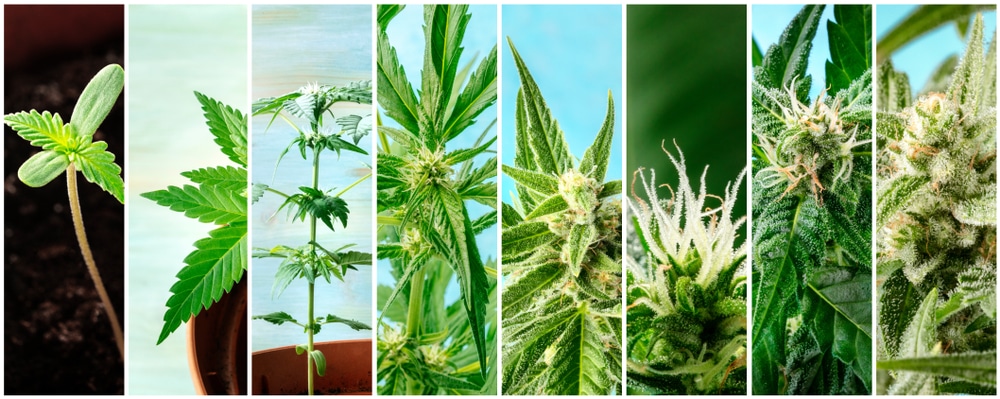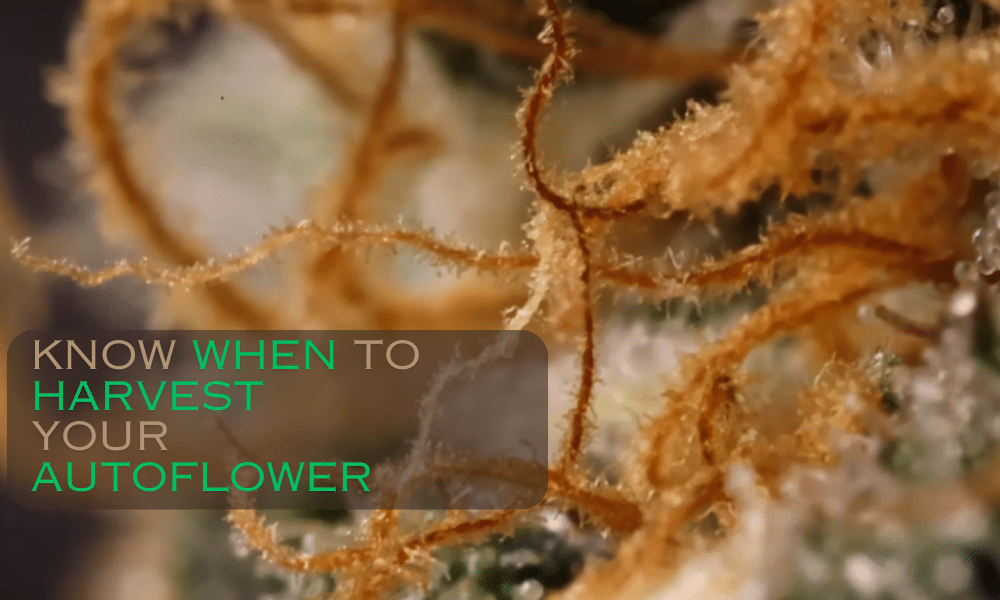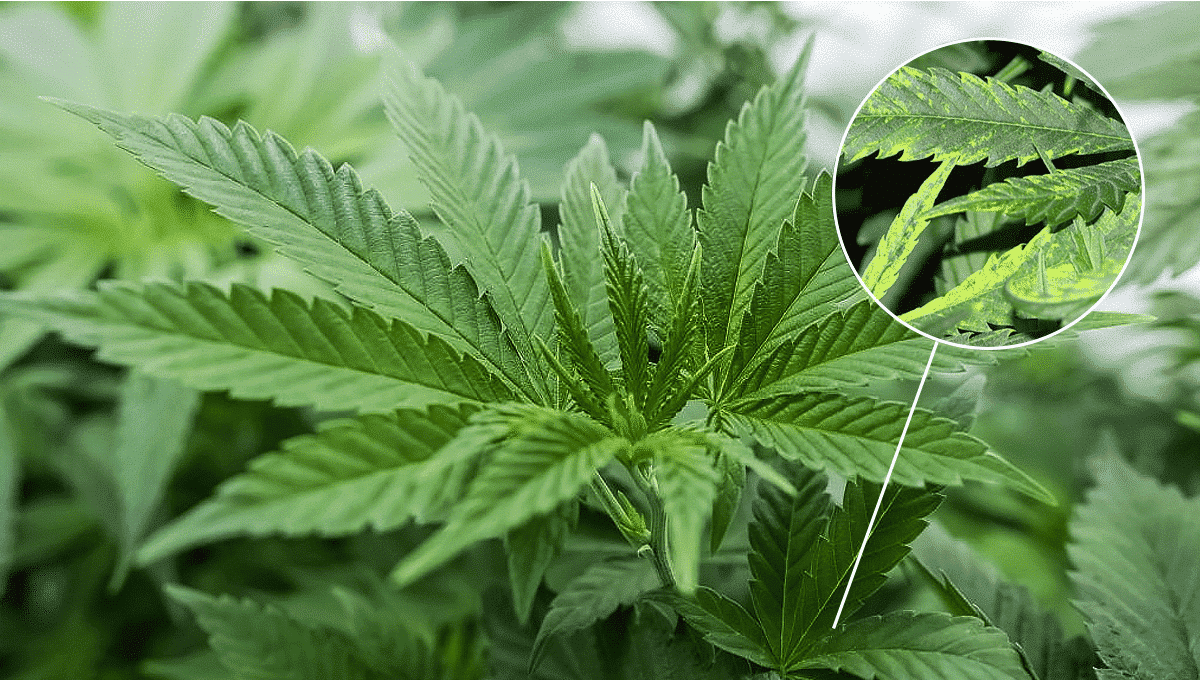No products in the cart.
Marijuana Education
How Long Does it Take Marijuana to Grow: A Seed-to-Harvest Timeline and Tips for Success
How long does it take marijuana to grow? Cultivating your own stash is exhilarating. From the moment a seed sprouts to the first toke of your homegrown bud, nothing compares. The rewards are rich but require careful timing, effort, and patience.
Some cannabis strains are harvest-ready in ten weeks, while others take up to eight months. This time frame depends on a few factors, including genetics and growing conditions.
A weed plant has distinct needs at each stage of its growth cycle. Cater to the characteristics and duration of these phases, and you’ll reap the rewards.
In this guide, you’ll learn about:
- The cannabis growth timeline.
- The four primary cannabis growth stages.
- Factors affecting your plant’s life cycle.
- The harvest, drying, and curing processes.
- 6 tips and tricks to speed up plant growth.
- Additional resources to expand your knowledge.
Ready to grow your green finger skills? Let’s get cracking.
How long does it take marijuana to grow?
It takes 3–8 months for a marijuana plant to grow from seed to harvest. Your chosen strain, setup, growing methods, and training techniques dictate the precise period.
Here’s a general breakdown of a marijuana plant’s life cycle:
| Cannabis growth stage | Duration |
| Germination | 1–10 days |
| Seedling | 2–3 weeks |
| Vegetative | 3–16 weeks |
| Flowering | 6–12 weeks |
| Total time from seed to harvest | 8–32 weeks |
Why such a drastic time difference, though?
The cannabis growth timeline is highly variable. Let’s look at its major contributing factors.
Top 3 factors affecting the cannabis growth timeline
The life cycle is different for every weed plant. Strain genetics, environmental conditions, and cultivation methods affect growth time. Let’s find out how.
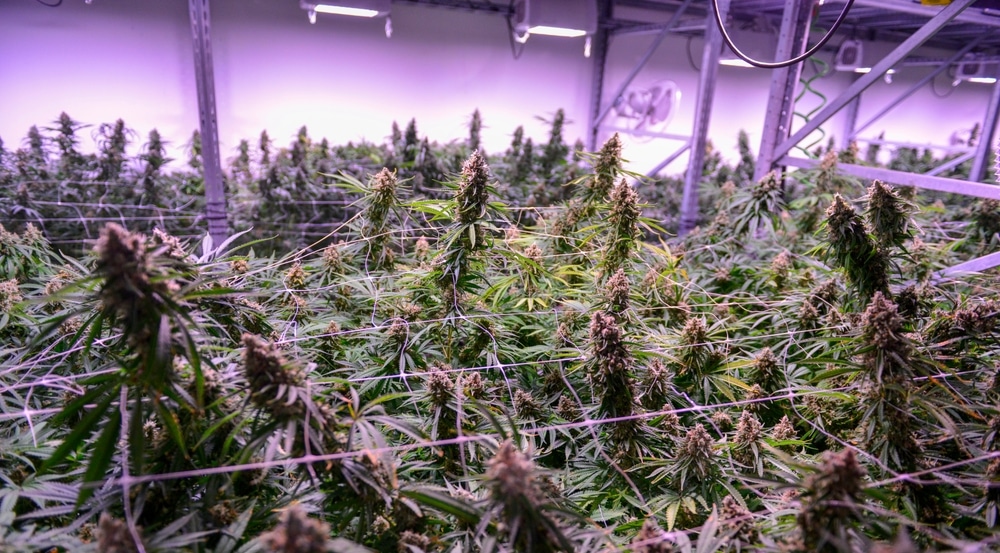
Cannabis strain genetics
Marijuana strains are often bred for their effects, flavors, and potency. Plant size, yield, and flowering times are also sought-after genetic traits.
Hundreds of cannabis strains exist. They each have distinct characteristics and a predetermined flowering period. Some are naturally quick-flowering, while others take longer to mature. And it’s all thanks to genetics.
Growth time differences among indica, sativa, and hybrid strains
Cannabis cultivars fall under the indica, sativa, or hybrid categories. Here’s how their growth times differ:
- Indica strains have a typical flowering time of around 8–10 weeks. They’re known for their broad leaves, stocky structure, and bulbous buds.
- Sativa strains take longer to bloom, with a flowering time of 12–14 weeks. These plants are usually taller than indica varieties. They have narrow leaves and elongated buds.
- Hybrid strains take 8–14 weeks to complete the flowering phase. Their dominant genetics dictate their growth traits.
The different flowering types also affect cannabis growth.
Photoperiod vs. autoflowering strains
Indica, sativa, and hybrid strains are either photoperiods or autoflowering plants. These two flowering types have a say in the life cycle, too.
- Regular and feminized cannabis seeds are photoperiodic. They rely on light cycle changes to start flowering. These plants are usually larger than auto varieties. They take an average of 16–20 weeks to mature from seed.
- Autoflowering seeds flower automatically, regardless of the light schedule. Their life cycle is short thanks to ruderalis genetics. While smaller, these crops are harvest-ready in around 8–10 weeks from germination.
- Fast cannabis seeds are photoperiodic too, but they also have ruderalis genes. This means a shorter life cycle than feminized or regular plants. They typically mature 6–10 weeks after sprouting.
A weed plant’s growth largely depends on genetics. But what environmental conditions are at play?
Environmental factors
Do you embrace the great outdoors? Or maybe you prefer indoor growing? Either way, your choice has a massive effect on cannabis growth.
Indoor vs. outdoor growing
Indoor growing enables a more precise and accelerated growth cycle. You have full control over lighting, ventilation, humidity, and temperatures. Should your weed plants flower early or keep vegging? You decide.
Things are a little different outside.
Outdoor cannabis plants rely on the sun’s natural rhythms to enter each growth stage. They flip into flower when the days get shorter, no matter when you planted them.
You have less control of the life cycle, but yields are often bigger and more flavorful. Plus, you can still extend the flowering phase with light deprivation techniques.
Light, temperature, and humidity
Cannabis crops need optimal light, temperature, and humidity levels to flourish. Naturally, these factors affect the growth timeline. Here’s how:
- Lighting enables photosynthesis. It regulates marijuana growth throughout the different stages.
- Warm temperatures boost plant growth, while colder conditions do the opposite.
- Humidity is the backbone of optimal plant development. Too high, and cannabis becomes a mold magnet. Too low, and nutrient absorption problems start.
Balance these factors properly to promote healthy growth within the ideal timeframe. The duration, quality, and quantity of your harvest will suffer otherwise.
Growing methods and training techniques
How long does it take marijuana to grow with a specific setup? It depends.
The growing medium
Some cultivation methods, like soilless grows or hydroponics, speed up the vegetative process. This shortens the overall life cycle of your cannabis plants.
A soil grow takes longer. It promotes natural nutrient uptake and a stable root system. But this medium requires more upkeep and care, which means extra time.
SOG vs. ScrOG and cannabis growth
Crop cycles are quicker with the Sea of Green (SOG). This yield-boosting technique spends little time on vegetative growth. Many smaller plants are flipped into flower early for fast, abundant harvests.
The Screen of Green (ScrOG) is the opposite, though it also amplifies yields. Scrogging requires fewer plants and slow vegetative growth. This means a longer timeline.
Cloning
While not a growing method per se, clones are also worth mentioning. These cuttings develop roots quickly, skipping the seedling stage. They reach harvest time 4–5 weeks faster than seed-grown cannabis.
From seed to harvest: The 4 cannabis growth stages
The growth cycle is like an excellent book. Each stage of growing marijuana from seeds reveals an exciting chapter about your crop:
- Germination is where it all begins.
- The seedling phase is delicate and tricky.
- The vegetative period is about explosive growth.
- And flowering? That’s when your hard work starts paying off.
Optimal lighting, water, and nutrient intake differ for every phase. The same goes for temperature and humidity levels. Understanding these intricacies is the key to gorgeously fat yields.
Stage 1: Seed selection and germination preparation
To choose the right cannabis seeds, consider your cultivation goals and needs. Do you want quick harvests? An easy grow? Potent buds? Relaxing or energizing effects?
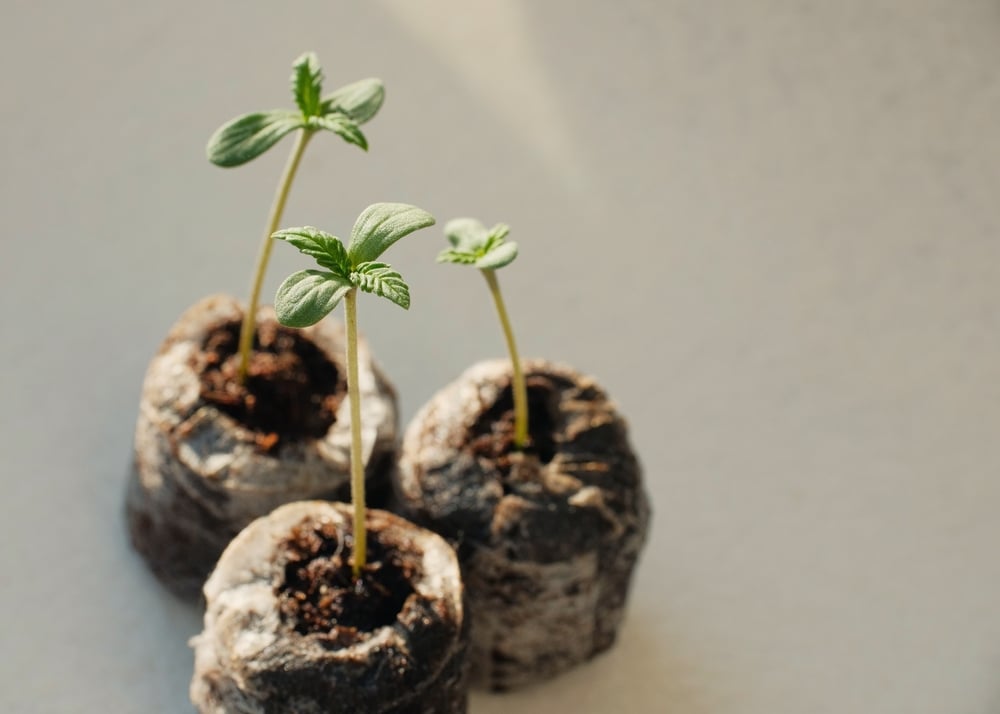
Do your research. Find strains suited to your growing environment and preferences. And remember, a bountiful harvest starts with high-quality marijuana seeds. Get yours from a reputable source like The Seed Fair for genetic stability and viable growth.
Germination duration and tips for success
Cannabis seeds take 1–10 days to germinate. It’s a delicate process requiring the utmost care. Here are five secrets for sprouting success:
- Sterilize your tools, working area, and hands before you start. Contaminants are lurking everywhere, ready to infect a helpless little seed.
- Use the paper towel method. Soak your weed seeds. Place them on a dinner plate between two moist (but not soaking) paper towels. Cover and store them in a warm, dark area.
- Check in every day and keep your marijuana seeds moist. Be patient. You can’t rush the germination process. Avoid questionable tactics like sandpapering or forcing their shells open.
- Plant your cannabis seeds. They’ve officially sprouted once their shell cracks open and a white taproot appears. Place them root-down in soil or another growing medium. Use a solo cup or 1-gallon starting container for each one.
- Keep your growing medium moist with a gentle spritzer. Handle your weed seedlings carefully and place them on a sunny windowsill.
Round cotyledon leaves emerge after a few days. As your marijuana plant grows, more leaves start to form. This signals the end of the germination phase.
Stage 2: Seedling greetings
The seedling stage starts when the first set of “true” leaves unfurl. They have a more typical shape with serrated edges and a pointed tip. Initially, you’ll notice one ridged “blade” or “finger” per leaf.
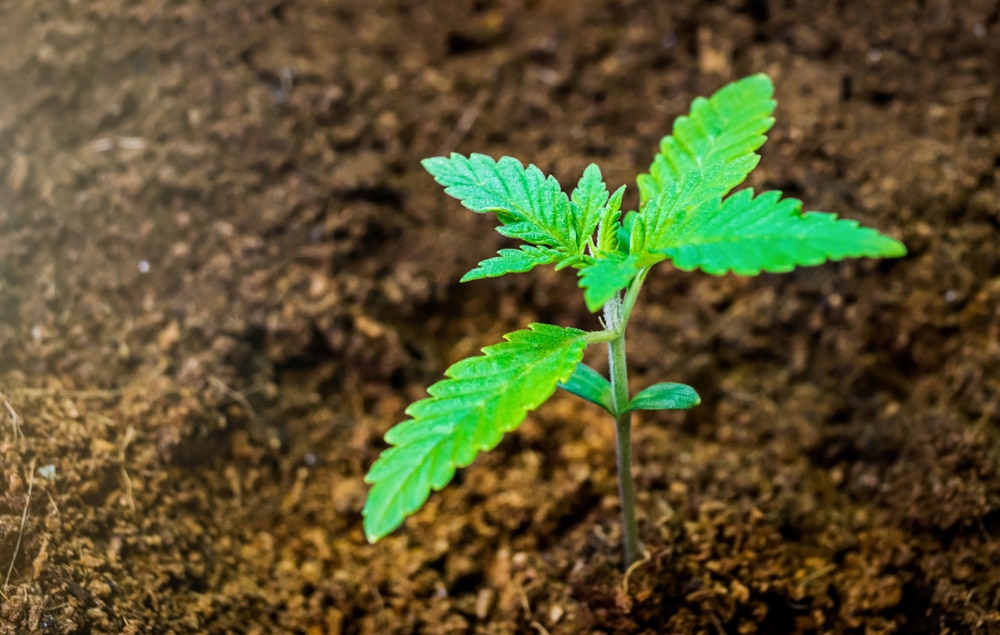
These blades increase as your seedlings grow. By the end of this phase, they’ll look a lot more like cannabis plants, with 5–7 blades per leaf. This, along with a vibrant green color, signifies healthy development.
Duration of the seedling stage and optimal care tips
The cannabis seedling stage lasts 2–3 weeks. Young plants are still super vulnerable during this time. Keep them healthy with these five care tips:
- Provide 16–18 hours of light every day. A sunny spot near a window works. You can also use white CFLs or LEDs.
- Stick to light watering. Mist your plants around the stem’s base. This prevents moisture buildup and encourages root development.
- Avoid rich fertilizers. Seedlings don’t need nutrients until the vegetative phase. Steer clear, or you’ll risk nute burn. Your pots and growing medium should also drain well.
- Cover your seedlings with a dome or plastic bag to trap moisture. Their roots are still developing, so water uptake happens via the leaves.
- Watch the humidity and temperature. Molds and diseases thrive in warm and moist conditions. Keep the ranges between 60–70% and 65–75°F, respectively.
Marijuana seedlings are susceptible to nutrient burn, overwatering, and pathogens. Look out for any warning signs. Discoloration, wilting leaves, and drooping stems are all red flags.
The seedling stage ends when a few sets of fan leaves appear.
Stage 3: Vegetative growth = explosive growth
With its new leaflets, a cannabis plant is ready to upscale photosynthesis. This is the beginning of the vegetative stage.
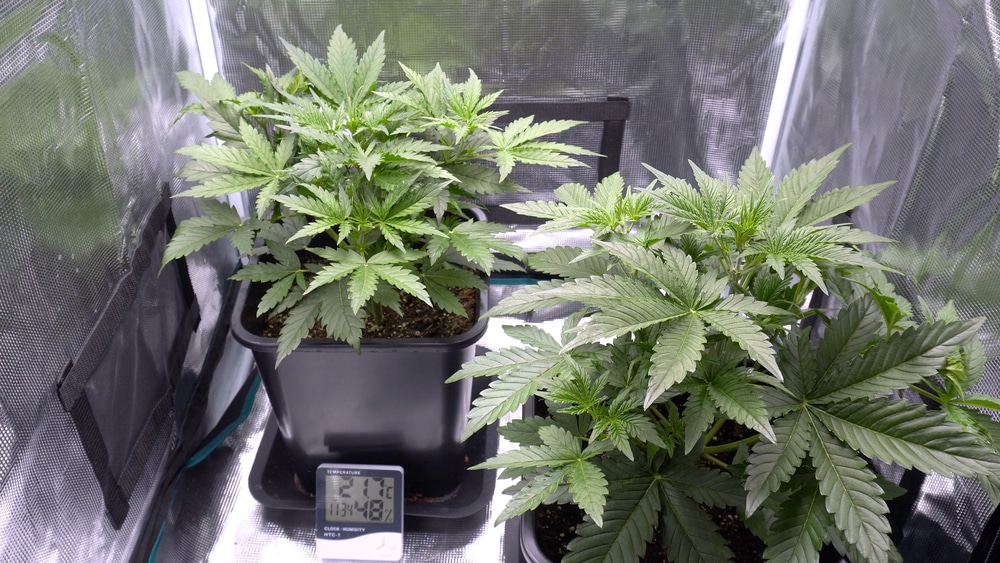
It’s all about getting bigger and stronger with more leaves and branches. Indica varieties grow bushy and more laterally. Sativa strains get tall and majestic.
The main stem shoots upward, and internodal spacing increases. The root zone expands too, in search of water and nutrients.
It soon outgrows the current container, and a transplant is usually required. A larger pot gives a cannabis plant more space for uninhibited root development.
Autoflowering strains develop too quickly to recover from transplanting. It’s best to plant them directly in their finishing container.
Duration and key factors in the vegetative stage
The vegetative stage lasts 3–16 weeks. It sets the stage for flowering. The bigger a cannabis crop gets, the more bud sites it develops. And the more colas it produces.
Your crops need adequate energy to support this explosive vegetative growth. That’s where you step in. Here are five key factors for robust plant development:
- Watering: Too much H2O can cause root rot and stunt growth. Lightly water your crops when the top inch of soil dries out
- Feeding: Vegging plants need nitrogen, potassium, and phosphorus to support various growth functions. Micronutrients like magnesium and calcium are vital too.
- Lighting: Give your indoor plants 18–24 hours of light per day to accelerate vegetative growth. Make sure greenhouse and outdoor crops get as much sunlight as possible.
- Humidity and temperature: While vegging, cannabis plants thrive in temps around 75–80°F. Humidity levels of 40–60% are also ideal. Ensure adequate airflow too.
- Transplanting: Transfer photoperiod plants to their final containers 1–2 weeks before flowering. The move is stressful. They need time to recover before bud development starts.
Now’s the time to start topping, pruning, scrogging, and fimming your plants. Training techniques stop a few weeks before flowering. Use the vegetative wisely to maximize yields.
Stage 4: Flowering is blooming
The flowering stage is where the magic happens. You can flip indoor plants into flower using a 12/12 light cycle.
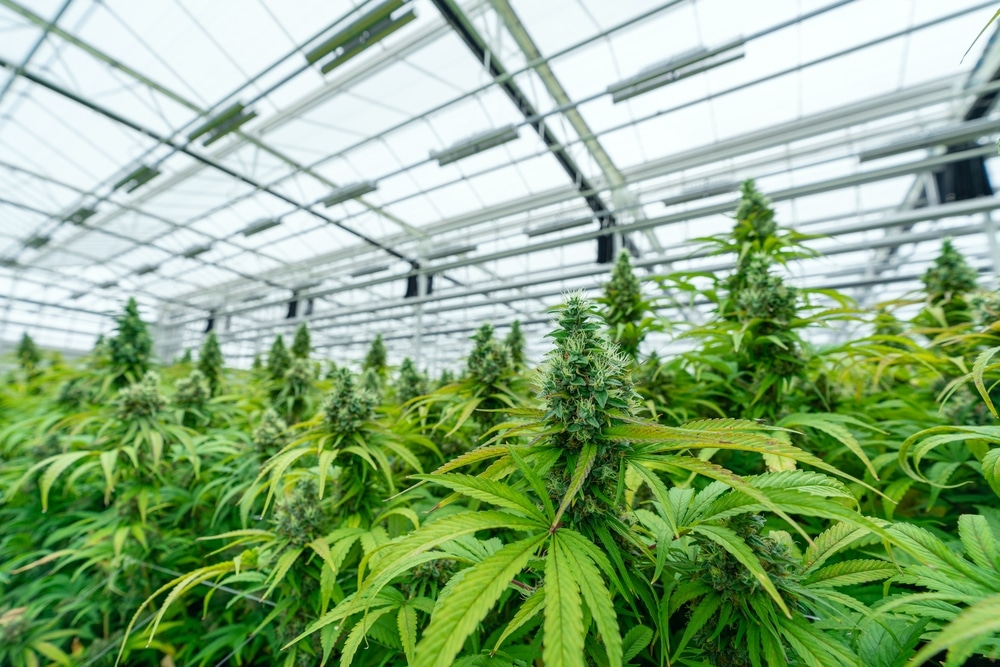
Outdoor crops flower when the seasons change and the days get shorter.
Autoflowers start blooming according to age rather than light schedules.
When flowering starts, a marijuana plant undergoes hormonal changes. This tells the crop to get ready for bud development.
Duration and care tips for the flowering stage
The flowering stage lasts around 6–12 weeks. Hybrid and indica photoperiods typically flower for 7–10 weeks. Some sativas take 14 weeks. As for autos, they only flower for about 30–45 days.
Flowering is divided into three sub-periods. Each one comes with unique growth changes and needs. Here’s a quick rundown:
Pre-flowering: Weeks 1–3
When the vegetative stage ends, an initial pre-flowering phase starts. It lasts around three weeks and is characterized by significant vertical growth. Cannabis plants typically double or triple in size. This “flowering stretch” is entirely normal.
Female crops soon develop long, whitish pistils at their nodes. Your resin-rich flowers will eventually blossom from these. Male plants produce round pollen sacs. You can now “sex” your plants if they were grown from regular seeds.
Mid-flowering: Weeks 5–6+
Upward and outward growth ceases at this stage, and flower production takes the wheel. Buds fatten up daily with white pistils and translucent trichomes. Aromas also become more noticeable.
Late flowering: Weeks 6–8+
Late flowering is the last stage of cannabis growth. By now, your buds are thick, heavy, and almost ripe.
You’re just waiting for the trichomes to turn milky white, with a few amber-colored ones. It’s a telltale sign that harvest time is around the corner.
Here are four vital care tips for the flowering stage:
- Flush your plants two weeks before harvest time. Always use pH-balanced water. This process makes for a smoother, tastier end result.
- Dial up the nutrients, but go slow. Cannabis plants respond well to increased phosphorus, potassium, and calcium. They need less nitrogen, though. Look out for nutrient deficiencies or overfeeding symptoms.
- Don’t stress your marijuana crops. It leads to stunted growth and, in extreme cases, hermaphroditism. The last thing you want is a self-pollinating plant ruining your harvest.
- Set up support. Cannabis plants get surprisingly heavy with all their juicy buds. Use stakes, plant clips, or string to keep them upright.
It’s nearly time to harvest!
The pre- and post-harvest processe
The harvesting process is a critical step in cannabis cultivation. After months of growing and meticulous care, the last thing you want is to mess it up.
Harvesting too early means the THC isn’t properly developed. Do it too late, and the THC degrades into cannabinol (CBN).
For optimal THC, flavors, and effects, chop your crops at the right time.
When to harvest cannabis
Cannabis is ready to harvest when it checks these boxes:
- When 90% of the pistils turn darkish red. They start out translucent, so they’re easy to spot.
- When 15% of the trichomes turn amber, 15% clear, and 70% milky-white. Get a pocket microscope or a jeweler’s loupe to examine them. It’s the best way to check if your cannabis plant is harvest-ready.
- When the leaves start yellowing. This signals the end of the marijuana plant’s growth cycle.
Now you know when to harvest weed. Let’s look at how to do it.
How to harvest cannabis in 4 steps
Choose a dry day to harvest your weed, and start early. Follow these steps:
Step 1: Gather your equipment
You’ll need a magnifying lens, trimming scissors, and gloves. Get a collection tray, airtight jars, and hangers, too. Your workspace should be clean, with an oscillating fan for air circulation.
Step 2: Cut the branches (or the whole plant)
Snip each bud-bearing branch off at the nodes. Lay them carefully on the tray to avoid damage. You can also cut down the whole plant if it’s a smaller variety.
Step 3: Trim the fan and sugar leaves
Cut away all the larger fan leaves. After that, trim off the sugar leaves. They’re sticky and close to the buds, so be gentle. The more thorough and careful you are, the better your buds will look. This is called wet trimming.
You can also do dry trimming after your buds have dried. This results in more compact and aesthetically pleasing nugs.
Step 4: Hang the branches
Hang each branch upside down and space them out evenly. The harvest area must remain dark with good airflow.
Drying and curing your buds
Drying and curing are the final stages of cannabis cultivation. They’re simple but require meticulousness.
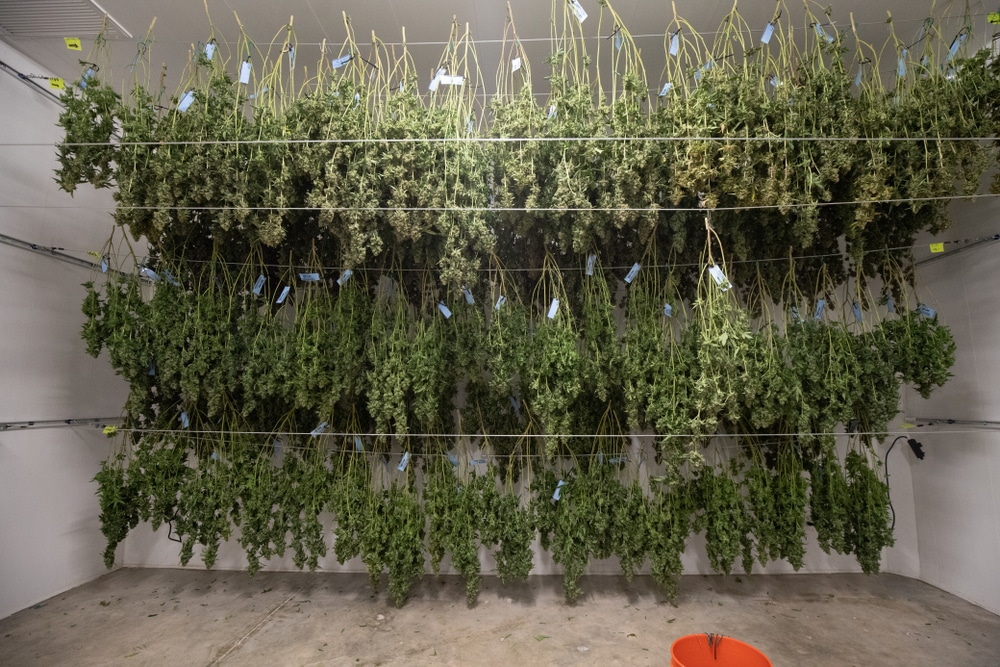
Drying cannabis
Drying takes around 2–7 days. The process removes moisture to prevent mold. Keep relative humidity levels at 50% with a temperature of 68°F.
Use a hygrometer to check the conditions daily.
When the flowers and stems snap instead of bending, the drying process is complete.
Curing cannabis
Next up is curing. This process takes around three weeks, but it enhances the value of your harvest. Curing is essentially a prolonged drying process. It’s non-negotiable if you want potent buds with a smooth and pleasant smoke.
Here’s how to cure your cannabis buds:
- Fill each airtight jar with your dried buds. They should be around 75% full.
- Seal them shut and store the jars in a cool, dark place.
- “Burp” your jars a few times a day. Keep them open for five minutes at a time. This dispels moisture for fresh air. Repeat the process for the first week.
- In the second and third weeks, you only have to open each jar once a day.
After that, your flowers will be adequately cured for a smooth smoke. You can extend the curing process to eight weeks for maximum flavor and potency.
How to speed up cannabis growth: 6 tips and tricks
Now you know how long marijuana takes to grow.
But can you speed up the process? Absolutely.
Here are six techniques to accelerate marijuana plant growth:
1. Keep the lights on 24/7 during veg
Keep your grow lights on 24/7 to speed up vegetative growth. You can cut vegging time down by one-third and still have a decent-sized plant. Keep an eye out for deficiencies, though.
2. Switch to an 11/13 light cycle during flowering
This method is designed to kickstart the flowering stage. Put your indoor plants in total darkness for 48 hours. Do it after switching to the 12/12 light cycle. Then, only give your plants 11 hours of light a day and 13 hours of darkness.
The reduced light “tells” cannabis plants winter is approaching. They’ll grow quicker with more urgency. This method is ideal for strains with shorter finishing times. Don’t use it on plants with longer growth periods. It’ll negatively affect yields.
3. Use light deprivation for outdoor plants
Outdoor growers can control the light cycle too. Cover your plants to restrict light exposure for 13–14 hours. This means 10–11 hours of sunlight a day. Use a frame with a light-proof material for one plant or many.
4. Opt for a hydro grow
Compared to soil, hydroponics can reduce vegetative growth by a few weeks. As a soilless grow, hydro delivers nutrients directly to the plant’s roots. Growth is quicker, and yields are bigger with fatter buds.
5. Use the ‘12/12 From Seed’ method
The 12/12 From Seed technique puts seedlings into flowering. All you do is give them a 12/12 light cycle from seed. The plants won’t be as big, and the yields will be lower, but they’ll be harvest-ready much quicker.
6. Implement the Sea of Green
The Sea of Green method uses lots of small plants vs. a few larger ones. Here, seedlings grow for around 4–5 weeks before flipping to flower.
As compact crops, they take less time to flower. But because there are a bunch of them, the yields are generous. Many growers use SOG with other harvest-boosting techniques like topping.
Balance speed and quality in cannabis cultivation
Some of the methods above sacrifice yield size for speed. That’s perfectly fine when you have lots of plants.
The Sea of Green is an excellent example. Overall yields are bigger, even though individual harvests are smaller. Strike the right balance. Sprout enough seeds to recreate this scenario with your chosen method.
Reap the rewards of a well-timed grow
How long does it take marijuana to grow? As you’ve seen, the answer is flexible. It depends on environmental factors, genetics, and personal preference.
Whether it’s three months or eight, the cannabis growth cycle has four main stages. Master them, and you’ll be on your way to bountiful harvests in no time.
Ask yourself what you want out of your cultivation journey.
From seed selection to sharpening your skills, we’re 100% here for it.


